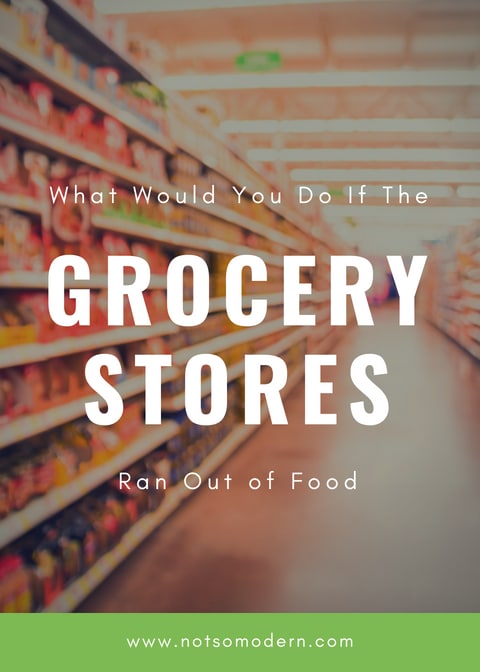We’re approaching the anniversary of Hurricane Irma, which makes me think more about what I should be doing to be more prepared for a hurricane.
August and September are the most volatile months of hurricane season. This is typically when we see more hurricanes as well as more powerful hurricanes. The most historic hurricanes have happened in August and September.
Granted, most of you do not live in hurricane country, but that doesn’t mean you shouldn’t be prepared. For you, August and September signify the end of summer. That means winter is just around the corner, and your own preparedness concerns will be here before you know it.
No matter what type of disaster we may face, one thing remains the same: we need to eat.
I’ve been reading the Little House on the Prairie books with my kids. It amazes me how much of pioneer life was centered around preserving food to get them through the winter. Many people died if they didn’t have enough food stored away, so it was a very real concern of theirs. Their greatest reality was the possibility of food insecurity.
In modern times, we can generally rely upon the grocery store. It may not always be the cheapest option, but we can be reasonably certain that they will have the foods we need when we need them. We can even purchase many vegetables that aren’t in season locally, if they can be grown locally at all.
The problem is that this convenience has made us complacent.
We don’t consider that the grocery store may run out of food, or we may not be able to make it to the grocery store.
What three things do grocery stores always run out of before a big storm? Water, bread, and milk.
Why?
Because we can survive for a few days with those three basic things.
But what happens when we can’t purchase those basic staples?
A Wake-up Call
Weather forecasting has come a long way. Hurricane forecasting in particular can warn us days or even weeks before a storm may make landfall. However, the storm can still be unpredictable. Hurricane Charlie changed course 2 hours before it was supposed to make landfall. Hurricane Irma was all over the map before it slammed into Florida. This is why we have the “cone of uncertainty.” If you are in the cone, you should plan for getting hit by a hurricane.
So imagine seeing reports of Hurricane Irma being a Category 5 hurricane and the entire state of Florida is in the cone.
There was a definite pucker factor.
A week before the storm, grocery stores started running out of bread, water, and milk. Only one problem…we were still a week away from landfall.
Now, keep in mind that Hurricane Harvey had just flooded the greater Houston area the week prior. Not only were those news stories still fresh in the minds of Floridians (and their concerned family members across the country), but a lot of emergency supplies had been routed away from the rest of the country and sent to Texas.
We were already going into Hurricane Irma with a shortage.
So when people bought all of that “emergency” food the week before the storm, they started eating it. And when they ran out of “emergency” food just before the storm, the grocery stores weren’t able to restock their shelves.
After a week of uncertain hurricane forecasts, food selection at the grocery store had gotten pretty slim. Memes were going around Facebook about creating Mystery Box cooking challenges with what we could find at the store.
Then the storm hit.
Most of our local grocery stores were without power for at least 24 hours. That meant any perishable foods they still had in stock were spoiled. They couldn’t just throw it away. They had to wait for trucks from their distributors to come take the spoiled food away. And the trucks weren’t coming right away, they had to visit every store in the state.
Then we had to wait for the trucks to make it back with fresh supplies.
Meanwhile, every household in the area needed to restock their fridges and freezers. They had either eaten all of the food they had on hand, or it had spoiled when their own power went out. Food was disappearing from shelves as quickly as it was being restocked.
It was a full two weeks after the storm before stores had full inventories again.
Let’s do the math. Food shortages started a week before Hurricane Irma made landfall. They continued for at least two weeks after the storm passed. That’s at least three weeks where we couldn’t rely upon the convenience of the grocery store.
And most people only plan for their emergency food supplies to last 72 hours.
So how do you plan for an extended period of time without a grocery store?
3 Strategies to Avoid Food Insecurity
Stockpile Early
One of the greatest risks people take when it comes to creating an emergency food supply is waiting until the last minute. This is when we usually see people panic and clear grocery store shelves.
A better strategy is to have all of your food set aside before you need it. For hurricane preparedness, that means putting together or adding to a kit at the beginning of hurricane season. If you are preparing for winter storms, then you should have your emergency food supply ready before the first snow falls.
If you have to rely upon purchasing your food supply, then budget how much you can set aside each week. Purchase extra supplies within your budget, and set them aside over time.
If you’re setting aside food yourself, you’ll need to focus on preserving the food when it’s in season for your area. This is when you’ll be able to harvest it from your garden, or purchase it in bulk at its best price. If you’re new to preserving food, do everything you can to research safe preparing and storage methods. While store bought canned goods can be stacked in a crate for emergency storage, home canned goods cannot and need to have sturdy shelves to store them on.
To learn more about home preserving, I recommend purchasing the Ball Complete Book of Home Preserving and checking out the National Center for Home Preservation website for tested safe recipes.
Easy to Prepare Meals
My backup plan if I couldn’t find bread to buy was to make bread from scratch. Only one problem…my generator wasn’t powerful enough to run my oven. Propane was in short supply, so we were using the grill very sparingly. And it had just rained for three days, so all of our wood for a campfire was soaked.
When it comes to cooking your emergency food, you are going to have to think outside of the box. Granted, most of the shelf stable foods we use in our emergency supply kits do not need to be reheated. They can be eaten directly from the package if we do not have a way to heat the food. Still, you may find that you need to boil water, in which case I recommend having a smaller heating element that will draw less power than your stove for emergency cooking. I ended up buying a Cadco PCR-1S Professional Cast Iron Range. It’s a little heavier duty than what most people need, but I wanted something that could also handle my canners, since both my water bath and pressure canners are too large for any of the burners on my stove.
With or without a range, I recommend looking into freeze dried foods. While the foods rehydrate faster with simmering water, they can also be soaked if you don’t have a way to heat your food. Freeze dried foods are easy to store because they are virtually weightless. You can also stock your pantry with everything from meats to fruits to dairy. And most of the foods have a shelf life of 25 years if left unopened and up to one year after they’re opened.
Long Term Food Storage
Explore a variety of preservation methods, especially those that don’t require freezing or refrigeration. Fermentation, freeze drying, dehydration, water bath canning, and pressure canning are all excellent options for preserving food.
While each comes with its own unique shelf life and storage method, you’ll find it easier to get by if you have a variety of foods to rely upon. There will be times when you need something quick, so beef jerky and other dehydrated snacks may be your best option, especially in a bug out bag when you may be on the move. You may desire the immune benefit or crisp texture of fermented vegetables. Or you may want a more balanced and filling meal that you can get with cooking with freeze dried foods.
Your emergency plan will also play a part in what types of food you set aside. If you plan to shelter from a winter storm in your home, you can store more canned and fermented goods. However, if you anticipate needing to evacuate due to flooding, fires, or hurricanes, you’ll want dehydrated and freeze dried foods that are lighter and easier to evacuate with.
Focus on Food Security
If we want to be prepared for anything, then we have to learn to be self reliant. The need for self reliance is never more obvious than during a natural disaster, when public assistance is stretched thin and may not reach many individuals for weeks, months, or years. This is why we must be prepared ahead of time.
The pillars of food security are availability, stability, access, and utilization. We can easily support three of those pillars by having a well thought out emergency food supply set aside in advance of a disaster. Utilization will come when we think through our emergency plan and the resources we will have available to store, evacuate with, and prepare our food. But it is also vitally important that we consider contingencies that may force us to be self reliant for longer periods than we had anticipated. Do you have enough food set aside? How will you prepare that food? What will you do when that food supply runs low? These are all factors we must consider to avoid food insecurity.

